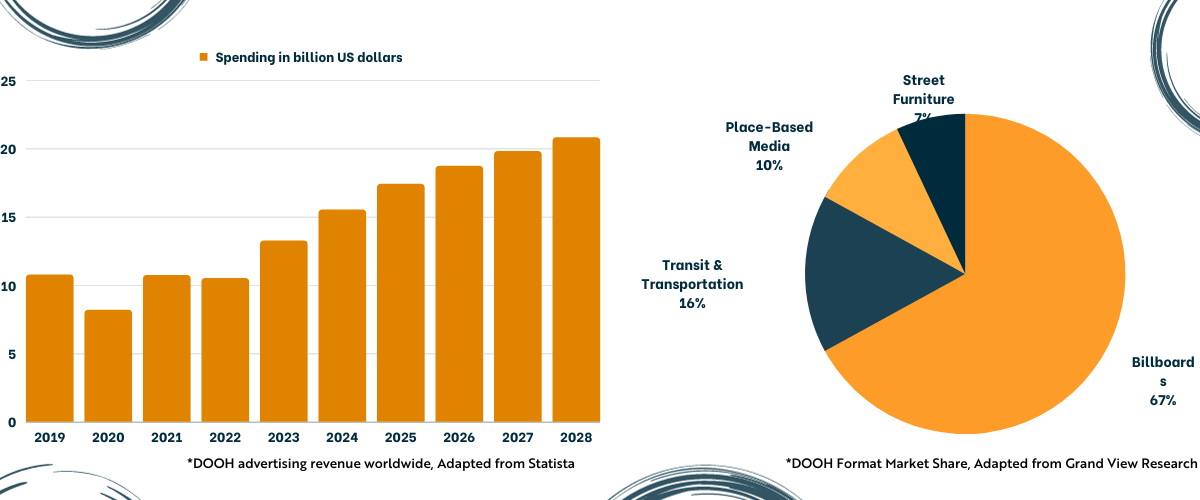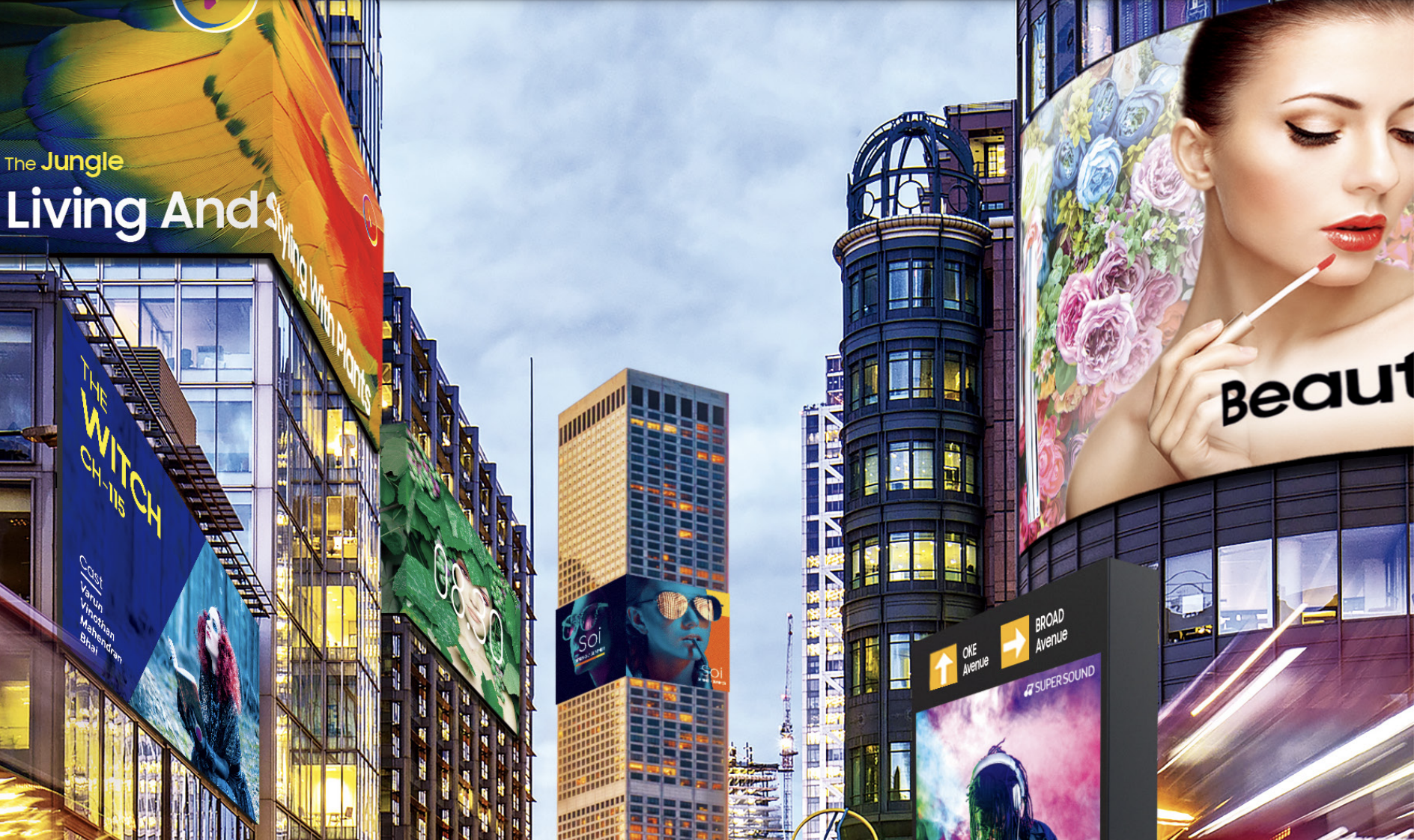As cities pulsate with life and change, so does the nature of how brands communicate with their audiences. Traditional media methods have long dominated our urban landscapes, but as technology drives us forward, the canvas of outdoor communication is being transformed. As we embrace the digital revolution, the horizons of outdoor marketing are expanding faster than ever.
From OOH to DOOH
Out-of-home or simply OOH is traditional outdoor advertising—it’s not digital and it’s not programmatic. It spreads messages to people when they are outdoors, in public places, commuting to work, or simply waiting at bus stops or elevators. Some typical OOH advertising mediums include billboards, bus stops, street furniture, on-car ads, etc.
Definition of DOOH
Digital out-of-home (DOOH) is basically a tech upgrade of out-of-home (OOH)—offering some of the technology advancements used in online display advertising, such as targeting and enhanced traffic data. At the same time, it has some big advantages. For example, people can’t use ad blockers to hide your content. Also, DOOH is far more creative in nature and captures the attention of bypassers.
Why is DOOH Better Than Traditional OOH?
Let’s imagine for a minute a world where billboards dynamically display content targeted to each individual simultaneously just as they’re walking past them. Imagine content distributed in a matter of minutes across your whole network of digital signage displays—or parts of it—being able to update or change information in real-time. Here comes software solutions like MagicINFO which are connected to your chosen database so you can create, schedule, and deploy content from a single location. This shortens the processing time and limits the chances of human error. Furthermore, MagicINFO makes it possible to tailor your content depending on the time of the day or maybe even weather conditions.
Digital-Out-of-Home Impact
As technology continues to evolve so does the influence of DOOH in our everyday lives. It has shifted the balance of media power, leaving many to wonder…
How Effective is DOOH?
A recent Neuroscience study conducted by Ocean Outdoor analyzes DOOH by using neuroscience and eye-tracking technologies. The study found that digital out-of-home displays capture attention, leading to improved brand recall and emotional engagement. So it’s not just about gathering views—it translates to tangible benefits like brand awareness and enhanced engagement. Moreover, the study observed that this brand engagement extends to social media, where people are more likely to interact and share DOOH content, amplifying the campaign’s reach. Because digital-out-of-home campaigns can be very impressive and attention-grabbing—the campaign is likely to end up all over social media which brings additional free exposure for the brand.
In public spaces making a bold statement is essential, and Samsung visualizes these business opportunities really well. From billboards to software – you can see display solutions for a wide array of outdoor applications in their portfolio.
But what makes DOOH campaigns effective?
Key findings emphasize:
- Seamless integration of your brand, portraying a cohesive message.
- Compelling storytelling: Crafting narratives that resonate with the audience, making the message memorable.
- Visual appeal: Using striking visuals that draw the eye and stay longer with your memory.
- CTA activation: Effective use of calls to action, urging the viewer to take a subsequent step, whether it’s visiting a website or checking out a product.
- Real-time content updates: Keeping content fresh and relevant, responding to real-time events or trending topics.
- Data analytics: Employing analytical insights to refine and optimize the campaign’s reach and effectiveness.
- Cross-platform collaborations: Collaborating with other platforms to expand reach.
Utilizing these insights enables businesses to connect with audiences more meaningfully and effectively in our current competitive world.
Some of The Most Common Applications of Digital-Out-Of-Home
- Billboards: No longer static, these are vibrant, moving displays that captivate audiences, whether they’re situated along highways or in bustling city centers.
- Street furniture: From bus stops to kiosks, digital displays offer both information and advertisement, enriching urban spaces with relevant content.
- Wayfinding: Interactive digital directories in all kinds of public spaces, guiding individuals and doubling as content platforms. You can inform and entertain customers with, for example, interactive maps and content.
- Ad-case: A modern take on poster advertising, these illuminated cases can be found in various outdoor settings, showcasing various content.
Another interesting thing to note—Statista reported that in 2023, the global digital-out-of-home advertising revenue will increase by over 26 per cent to almost 13.3 billion U.S. dollars as shown on the chart below. This increase reflects not just the technological advancements but also the shifting preferences of brands towards more dynamic and engaging ways to communicate with their audience. As urban spaces continue to modernize, the integration of DOOH becomes an essential part of this transformation. Moreover, projections indicate a further growth of more than 50 per cent in the next five years, indicating a promising future for the industry.

To Conclude: What’s the Future of DOOH?
Digital Out-of-Home, or DOOH, isn’t simply a technological shift—it’s a transformation that reimagines how brands communicate and how audiences perceive. In a world flooded with media noise, the physical nature of DOOH gives it an undeniable presence. Yet, its seamless integration with dynamic, real-time technologies ensures it’s anything but static. With brands like Samsung pioneering the way forward, it’s evident that the potential of DOOH is vast, extending beyond communication to powerful experiences.
The synergy between DOOH and other digital platforms such as social media only amplifies its impact. As the boundary between the physical and digital world continues to blur, businesses that harness the strength of digital signage in outdoor space, apply its insights, and maintain consistency in their messaging and storytelling, will undoubtedly stand out in their communication.
In essence, the future of marketing isn’t just digital—it’s out-of-home, in real-world, dynamic, and responsive. As brands continue to navigate this frontier, one thing is clear: DOOH is more than just a trend; it’s a new cornerstone for impactful media.
Discover the world of digital signage full of immersive and engaging possibilities. Join the Global Signage Alliance to speak at leading digital signage events, get the latest industry updates, and much more as a member. Embrace the future of interactive experiences with us.


